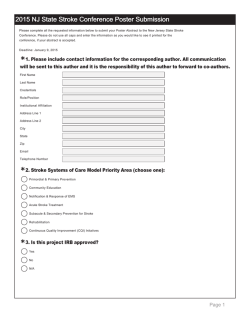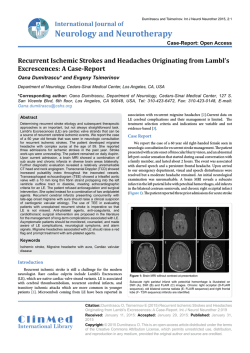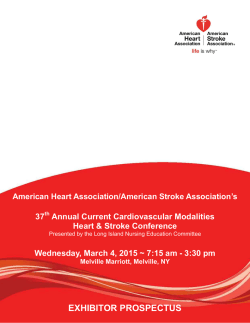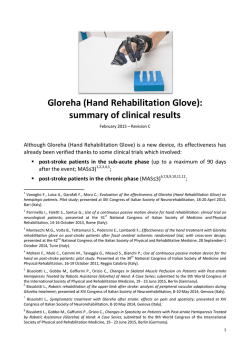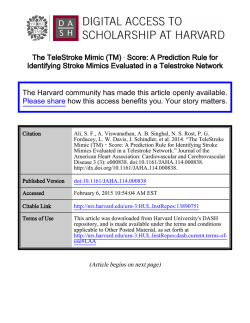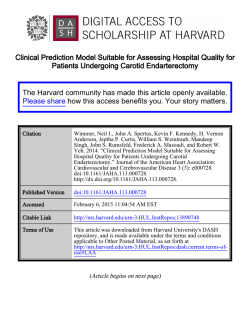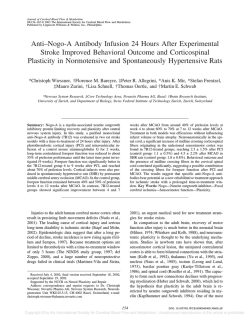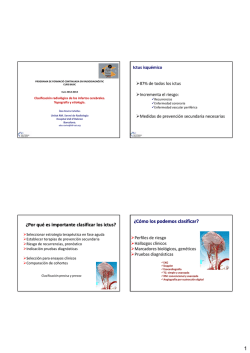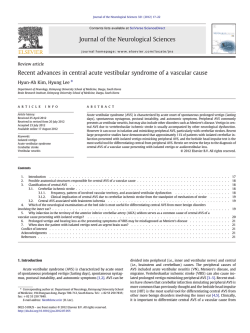
Requirements for Acute Stroke–Ready Hospital
• Issued February 2, 2015 • Prepublication Requirements The Joint Commission has approved the following revisions for prepublication. While revised requirements are published in the semiannual updates to the print manuals (as well as in the online E-dition®), accredited organizations and paid subscribers can also view them in the monthly periodical The Joint Commission Perspectives®. To begin your subscription, call 877-223-6866 or visit http://www.jcrinc.com. Official Publication of Joint Commission Requirements Requirements for Acute Stroke–Ready Hospital Advanced Certification Applicable to Acute Stroke–Ready Hospital Advanced Certification Effective July 1, 2015 Program Management (DSPR) Standard DSPR.1 The program defines its leadership roles. Elements of Performance for DSPR.1 A 1. The program identifies members of its leadership team. a. The organization appoints an Acute Stroke Ready medical director. Note: An Acute Stroke Ready medical director does not have to be board certified in neurology or neurosurgery but must have sufficient knowledge of cerebrovascular disease to provide administrative leadership, clinical guidance, and input to the program. A 2. D The program defines the accountability of its leader(s). a. Written documentation shows support of the Acute Stroke–Ready program by hospital or health system administration. A 4. D The program leader(s) identifies, in writing, the composition of the interdisciplinary team. a. The organization appoints an acute stroke team to manage patients who present with this condition. b. The acute stroke team should include, at a minimum, a nurse (or nurse practitioner or physician assistant) and a physician. Each member of the acute stroke team has basic training in acute stroke care such as prior experience in neuroscience intensive care, completion of continuing education in areas of acute stroke care, or attendance at regional or national courses dealing with acute stroke care. c. The program documents the roles and responsibilities for members of the acute stroke team. Standard DSPR.2 The program is collaboratively designed, implemented, and evaluated. Element of Performance for DSPR.2 A 1. The interdisciplinary team designs the program. a. The organization defines its interdisciplinary team so that it reflects the needs of the patient. Standard DSPR.3 The program meets the needs of the target population. Element of Performance for DSPR.3 A 4. The services provided by the program are relevant to the target population. a. The hospital collaborates with emergency medical services (EMS) providers to make certain of the following: l The program has a relationship with EMS providers that includes notification when a patient with suspected stroke is being transported to the acute stroke ready hospital. l The program has access to treatment protocols utilized by EMS providers and prehospital personnel for emergency stroke care. l The program has protocols for working with EMS to facilitate the transport and transfer of acute stroke patients in a timely manner to the most appropriate facility. l The program works collaboratively with EMS to establish that personnel have specific training in the use of at least one accepted field assessment tool. Key: A indicates scoring category A; C indicates scoring category C; D indicates that documentation is required; M indicates Measure of Success is needed; indicates an Immediate Threat to Health or Safety; indicates situational decision rules apply; indicates direct impact requirements apply; indicates and identified risk area Copyright 2015 The Joint Commission 1 Prepublication Requirements continued February 2, 2015 b. Hospitals that provide stroke care to rural areas have protocols that address the prompt diagnosis and emergency treatment of stroke patients. c. The program has a written criteria for the admission, transfer, and discharge of stroke patients. d. The hospital has a written transfer protocol with at least one primary stroke center or one comprehensive stroke center or a stroke center of comparable capability. e. Written transfer protocols with accepting facilities include the following: l Contact names l Contact phone numbers l Ability to transfer 24 hours a day, 7 days a week l Ground and air transportation options f. The program has access to stroke expertise 24 hours a day, 7 days a week. Note: Access to stroke expertise may be in person or via telemedicine. If via telemedicine, there is the capability for a live interactive physical exam with real-time viewing of the patient and neuroimaging studies. g. Medical professionals providing remote medical guidance have training and expertise similar to primary or comprehensive stroke center providers. Standard DSPR.5 The program determines the care, treatment, and services it provides. Elements of Performance for DSPR.5 A 1. D The program defines in writing the care, treatment, and services it provides. a. The organization’s formulary or medication list must include an IV thrombolytic therapy medication approved by the US Food and Drug Administration for the treatment of ischemic stroke. A 3. The program provides care, treatment, and services to patients in a planned and timely manner. a. The acute stroke team is on-call 24 hours a day, 7 days a week, with the ability of at least one member to be at the patient’s bedside within 15 minutes of being called. Note: The organization may choose to maintain a consistent team or group of practitioners for this purpose, or it may choose to rotate this responsibility as needed. These practitioners may include physicians, nurses, nurse practitioners, and physician assistants from any unit or department as determined by the organization. b. The hospital has the ability to complete initial laboratory tests on-site 24 hours a day, 7 days a week. Note: Laboratory tests include a complete blood cell count with platelet count, coagulation studies (pro- Copyright 2015 The Joint Commission thrombin time, international normalized ratio), blood chemistries, and troponin. c. The hospital has the ability to perform computed tomography (CT) of the head on-site 24 hours a day, 7 days a week. Note: A brain magnetic resonance imaging (MRI) may be performed in lieu of a head CT if the same parameters can be met in the acute setting. A 6. The program has a process to provide emergency/urgent care. a. The program has at least one physician, nurse practitioner, or physician assistant on site to supervise patient care, order medication, and manage emergent issues. Note: The nurse practitioner or physician assistant must have prescriptive authority and the ability to consult with a covering physician if needed. b. The hospital has designated practitioners knowledgeable in the diagnosis and treatment of stroke who are responsible for responding to patients with an acute stroke 24 hours a day, 7 days a week. c. The organization has written documentation on the process used to notify the designated practitioners who respond to patients with an acute stroke. d. Emergency department licensed independent practitioners have 24-hour access to a timely, informed consultation about the use of IV thrombolytic therapy, which is provided by a physician privileged in the diagnosis and treatment of ischemic stroke. Note: For the purpose of The Joint Commission’s Acute Stroke Ready Hospital Certification, an informed consultation includes bedside consultation or telemedicine consultation from a privileged physician. A 7. The program provides the number and types of practitioners needed to deliver or facilitate the delivery of care, treatment, and services. a. Neurosurgical coverage is documented in a written plan and is approved by the covering neurosurgeon(s), stroke program leaders, and any involved facilities. b. Neurosurgical services are available to patients within three hours of it being deemed necessary. c. There is a written protocol for transfer that includes communication and feedback from the receiving facility. Standard DSPR.6 The program has current reference and resource materials. Element of Performance for DSPR.6 A 1. Practitioners have access to reference materials, including clinical practice guidelines, in either hard copy or electronic format. 2 Prepublication Requirements continued February 2, 2015 a. Protocols and care paths (preprinted or electronic documents) are available in the emergency department and in other acute care areas for the acute assessment and treatment of patients with ischemic or hemorrhagic stroke. Delivering or Facilitating Clinical Care (DSDF) Standard DSDF.1 Practitioners are qualified and competent. Elements of Performance for DSDF.1 A 1. D Practitioners have education, experience, training, and/ or certification consistent with the program’s scope of services, goals and objectives, and the care provided. a. The organization’s clinical staff have knowledge of the process used to notify designated practitioners of the need to respond to patients with an acute stroke. b. Emergency department practitioners demonstrate knowledge of IV thrombolytic therapy protocols for acute stroke, including the following: l Treatment during the first three hours after the patient was last known to be well l Indications for use of IV thrombolytic therapy l Contraindications to IV thrombolytic therapy l Education to be provided to patients and families regarding the risks and benefits of IV thrombolytic therapy l Signs and symptoms of neurological deterioration post IV thrombolytic therapy A 7. Ongoing in-service and other education and training activities are relevant to the program’s scope of services. a. Members of the core stroke team, as identified by the organization, receive at least four hours annually of continuing education or other equivalent educational activity related to the care of patients with cerebrovascular disease. b. Emergency department staff, as defined by the organization, participates in educational activities related to stroke diagnosis and treatment a minimum of twice a year. Note: This requirement does not include emergency physicians. For more information, refer to Standard MS.12.01.01 in the Hospital E-dition of the Comprehensive Accreditation Manual for Hospitals. c. The medical director of the program (if not part of the core stroke team) receives annually at least four hours of education related to the care of patients with cerebrovascular disease. Standard DSDF.2 The program develops a standardized process originating in Copyright 2015 The Joint Commission clinical practice guidelines (CPGs) or evidence-based practice to deliver or facilitate the delivery of clinical care. Elements of Performance for DSDF.2 A 2. The selected clinical practice guidelines are based on evidence that is determined to be current by the clinical leaders. a. The program has written protocols based on clinical practice guidelines, including the following: l Protocols for emergent care of patients with ischemic stroke l Protocols for emergent care of patients with hemorrhagic stroke b. The dysphagia screen used by the program is an evidence-based testing protocol approved by the organization. c. Protocols for IV thrombolytic therapy, when indicated, are reflected in the order sets or pathways and utilized in the acute care of the stroke patient. d. Time parameters for stroke workup are included in a stroke assessment protocol or the emergency department stroke protocol. A 3. D The program leader(s) and practitioners review and approve clinical practice guidelines prior to implementation. a. Protocols for emergent care of patients with ischemic and hemorrhagic strokes are reviewed for current evidence at least annually and revised as necessary using an interdisciplinary approach. A 4. Practitioners are educated about clinical practice guidelines and their use. a. The hospital demonstrates that 67% of emergency department practitioners are educated in acute stroke protocol(s). Standard DSDF.3 The program is implemented through the use of clinical practice guidelines selected to meet the patient’s needs. Elements of Performance for DSDF.3 C 2. The assessment(s) and reassessment(s) are completed according to the patient’s needs and clinical practice guidelines. M a. An emergency department physician, nurse practitioner, or physician assistant performs an assessment for a suspected stroke patient within 15 minutes of patient arrival in the emergency department. Note: Nurse practitioners and physician assistants performing the initial assessment must have prescriptive authority and the ability to consult with a covering physician if needed. b. Ongoing assessment(s) of the patient are completed in 3 Prepublication Requirements continued February 2, 2015 accordance with the program’s acute stroke protocols. c. The National Institutes of Health Stroke Scale (NIHSS) is used for the initial assessment of patients with acute stroke. Note: The NIHSS is completed by a qualified member of the team as determined by the organization. d. A blood glucose level is completed for any patient presenting with stroke symptoms. e. The hospital has the ability to perform and read a noncontrast head CT or MRI within 45 and 60 minutes, respectively, of being ordered. Note: Review of the images does not have to be done on site. Evaluation can be performed through telemedicine. Images must be reviewed by a board-certified radiologist or other physician with expertise in reading head CT or brain MRI images. f. Laboratory tests, electrocardiogram (ECG), and chest x-ray are completed and resulted within 45 minutes of patient presentation with stroke symptoms, if ordered by the practitioner. Note: Laboratory tests may include a complete blood cell count with platelet count, coagulation studies (prothrombin time, international normalized ratio), blood chemistries, and troponin. g. All patients exhibiting stroke symptoms are screened for dysphagia prior to receiving any oral intake of medication, fluids, or food. h. The hospital has a process to notify medical staff and other personnel about the deterioration of a stroke patient, which may include, but is not limited to, changes in vital signs and neurological status. C 3. The program implements care, treatment, and services based on the patient’s assessed needs. M a. If brain magnetic resonance imaging (MRI) is required in place of a head CT, it is completed and interpreted within one hour of being ordered. b. The completion of laboratory tests, electrocardiogram (ECG), and chest x-ray should not delay the administration of IV thrombolytics. c. Telemedicine/teleradiology equipment is on site for transmission of information. d. Telemedicine link is initiated within 20 minutes of the emergency physician/acute stroke team determining it is necessary. Standard DSDF.5 The program manages comorbidities and concurrently occurring conditions and/or communicates the necessary information to manage these conditions to other practitioners. Element of Performance for DSDF.5 C 1. The program coordinates care for patients with multiple health needs. M Copyright 2015 The Joint Commission a. Protocols for care related to patient referrals demonstrate that the program does the following: l Addresses processes for transferring patients to another facility l Evaluates the receiving organization’s ability to meet the individual patient’s and family’s needs b. Based on prognosis and the patient’s individual needs and preferences, patients are referred to palliative care when indicated. c. Based on prognosis and the patient’s individual needs and preferences, patients are referred to hospice or end-of-life care when indicated. d. For patients transferring to a stroke center, patients should leave the hospital within two hours of emergency department arrival or when medically stable. The program includes time parameters and transfer procedures to the stroke center. Standard DSDF.6 The program initiates discharge planning and facilitates arrangements for subsequent care, treatment, and services to achieve mutually agreed-upon patient goals. Element of Performance for DSDF.6 C 4. The program provides education and serves as a resource, as needed, to practitioners who are assuming responsibility for the patient’s continued care, treatment, and services. a. The acute stroke ready hospital makes educational opportunities available to prehospital personnel, as defined by the organization. Clinical Information Management (DSCT) Standard DSCT.4 The program shares information with relevant practitioners and/ or health care organizations about the patient’s disease or condition across the continuum of care. Element of Performance for DSCT.4 C 2. The program shares information with relevant practitioners and/or health care organizations to facilitate continuation of patient care. a. The following results are communicated and available to the ordering provider and stroke team, as applicable: l Head computed tomography (CT) l Computed tomography angiography (CTA) l Brain magnetic resonance imaging (MRI) l Magnetic resonance angiography (MRA) lLaboratory 4 Prepublication Requirements continued February 2, 2015 Standard DSCT.5 The program initiates, maintains, and makes accessible a medical record for every patient. Elements of Performance for DSCT.5 C 4. The medical record contains sufficient information to justify the care, treatment, and services provided. M a. Documentation indicates the reason eligible ischemic stroke patients did not receive IV thrombolytic therapy. C 5. The medical record contains sufficient information to document the course and results of care, treatment, and services. M a. Stroke program practitioners document all assessments and interventions provided for stroke patients, including date and time, in accordance with the hospital’s policy. Performance Measurement (DSPM) Standard DSPM.1 The program has an organized, comprehensive approach to performance improvement. Elements of Performance for DSPM.1 A 1. D The program leader(s) identifies goals and sets priorities for improvement in a performance improvement plan. a. The program monitors its ability to administer IV thrombolytics within 60 minutes to eligible patients presenting for stroke care. A 2. The program leader(s) involves the interdisciplinary team and other practitioners across disciplines and/or settings in performance improvement planning and activities. a. At a minimum, the stroke team log includes the following information for each entry: l Number of times stroke team was activated l Practitioner response time to acute stroke patients (See also DSPR.5, EP 3a; DSDF.3, EP 2a) l Type(s) of diagnostic tests and acute treatment if used l Patient diagnosis l Door-to-IV thrombolytic time l Patient complications l Disposition of the patient (for example, upon admission to the organization, discharge, transfer to another organization) b. The program utilizes a stroke registry or similar data collection tool to monitor the data and measure outcomes. c. The program monitors its IV thrombolytic complications, which include symptomatic intracerebral hemorrhage and serious life-threatening systemic bleeding. Note 1: Symptomatic intracerebral hemorrhage is defined by a completed computed tomography (CT) prior to transfer that shows intracerebral hemorrhage along with a physician’s note indicating clinical deterioration due to intracerebral hemorrhage. Note 2: Serious, life-threatening systemic bleeding is defined as bleeding prior to transfer requiring multiple transfusions along with a physician’s note attributing IV thrombolytics as the reason for multiple transfusions. a. Stroke performance measures are analyzed by the stroke team and the hospital’s quality department. b. The program has a specified committee that meets a minimum of twice per year to evaluate protocols and practice patterns as indicated. A 5. The program collects data related to its target population to identify opportunities for performance improvement. a. The program has documentation to reflect tracking of performance measures and indicators. Standard DSPM.3 The program collects measurement data to evaluate processes and outcomes. Note: Measurement data must be internally trended over time and may be compared to an external data source for comparative purposes. Element of Performance for DSPM.3 A 2. The program collects data related to processes and/or outcomes of care. Copyright 2015 The Joint Commission 5
© Copyright 2025
